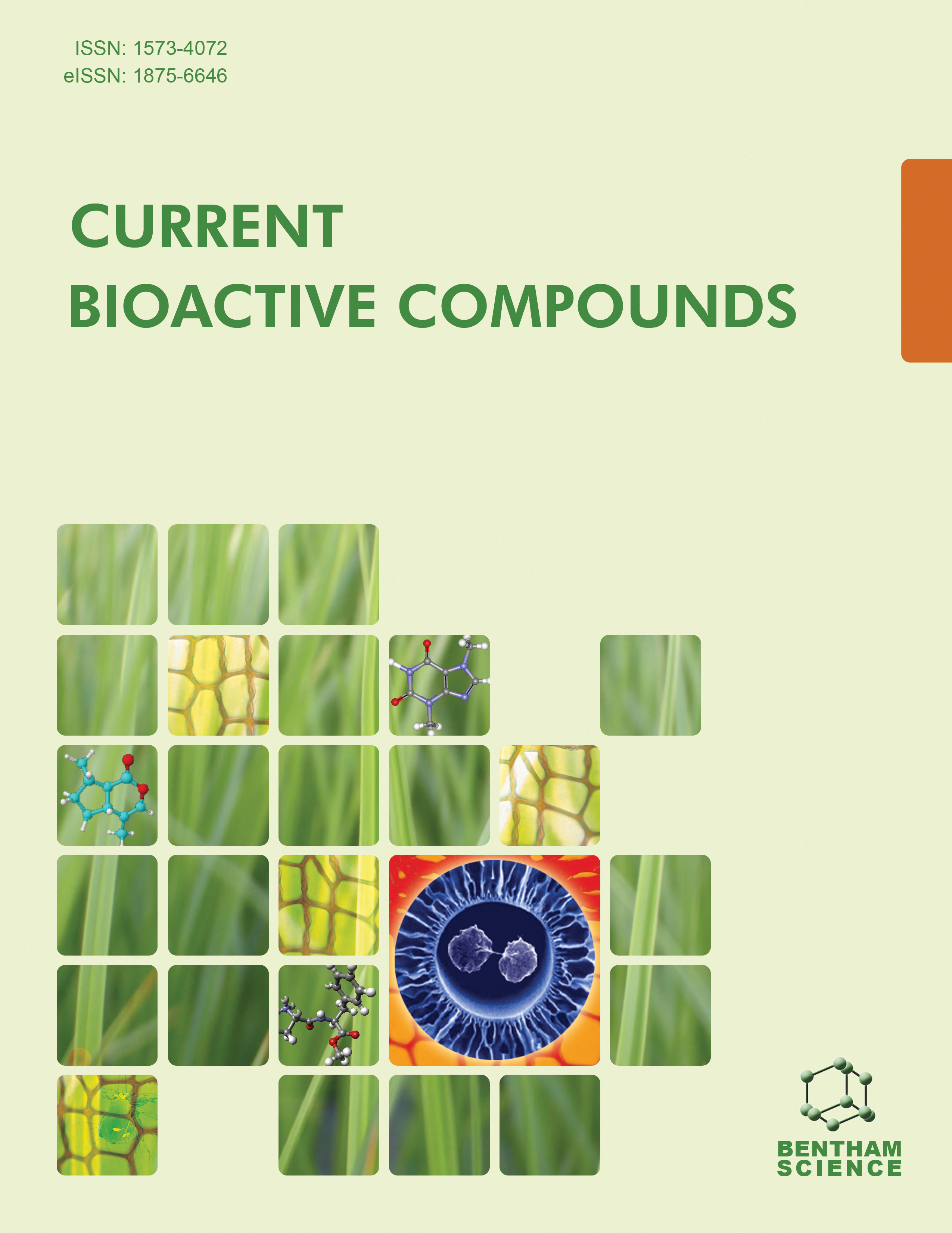- Home
- A-Z Publications
- Current Bioactive Compounds
- Previous Issues
- Volume 18, Issue 4, 2022
Current Bioactive Compounds - Volume 18, Issue 4, 2022
Volume 18, Issue 4, 2022
-
-
Uncaria tomentosa (Willd. ex Schult.): Focus on Nutraceutical Aspects
More LessMedicinal plants have been globally exploiting as an alternative to chemical drugs in the treatment of several diseases due to low unwanted side effects, environmentally friendly nature, and low production costs. Therefore, it is important to analyze the therapeutic properties of various medicinal plants to understand their potential bioactivity. Uncaria tomentosa is one of these medicinal plants with many health-promotin Read More
-
-
-
Impact of Physicochemical Parameters on Effective Extraction of Bioactive Compounds from Natural Sources: An Overview
More LessBackground: Bioactive compounds obtained from natural sources like plants, algae, mushrooms and marine have become of utmost importance in the pharmaceutical, food and cosmetic industries. Many bioactive chemicals have been found to have health-promoting characteristics, including antioxidant, antidiabetic, antibacterial, and anticancer activities. Extraction of these bioactive chemicals from natural sources is difficult Read More
-
-
-
Optimization of Phenolic Compound Recovery and Antioxidant Activity of Bay Leaves using Sequential and Response Surface Methodologies
More LessAuthors: Yazid K. Khodja, Mostapha Bachir-Bey, Rachid Ladjouzi and Bachra KhettalBackground: The laurel is a shrub native to the Mediterranean basin. It is too often wrongly relegated to the kitchen as a simple condiment while it possesses many therapeutic properties and virtues. The valorization of this plant in terms of bioactive compounds seems to be important. Objective: The aim of the present study is to optimize total phenolic content (TPC) extraction and antioxidant activity from dried bay leav Read More
-
-
-
The Hepatoprotective Role of Warburgia salutaris and Iso-Mukaadial Acetate on Carbon Tetrachloride Intoxicated Rats Model
More LessAuthors: Gideon Ayeni, Mthokozisi B. C. Simelane, Md. S. Islam and Ofentse Jacob PooeBackground: Medicinal plants, together with their isolated bioactive compounds, are known for their antioxidant properties, which constitute therapeutic agents that are routinely employed in the treatment of liver diseases. Aims of the Study: The current study sought to explore the protective role of Warburgia salutaris and its isolated compound, iso-mukaadial acetate, against carbon tetrachloride (CCl4)-induced he Read More
-
-
-
Essential Oils and Alcohol Extracts of Northwest Tunisia M. communis and M. spicata: Phytocompounds, Antioxidant and Antibacterial Activities
More LessAuthors: Saida Medjeldi, Nora Benrachou, Sabrina Bouchelaghem, Sélim Jallouli, Nadia Farès and Salem ElkahouiBackground and Objective: Nowadays, the conventional chemical compounds used in the food, pharmaceutical, and cosmetic sectors have proven to be less efficient from an economic and health point of view. Research has therefore focused on the isolation of bioactive molecules from plants or microorganisms . Methods: The study focused on the leaf’s volatile compounds determination from Myrtus communis (McEOs) and M Read More
-
-
-
Bioaccessibility, Antioxidant and Antibacterial Potentials of Phenolic Compounds Ultrasonically Extracted from Acerola Malpighia glabra DC Coproduct
More LessBackground: This study assessed the effects of solvent proportion, time and power intensity of ultrasound processing on the extraction, bioaccessibility, antioxidant and antimicrobial activity of phenolic compounds (PC) from acerola (Malpighia glabra DC) coproduct (ACP). Methods: The ultrasound process with water as a solvent in a ratio of 1:2, power intensity of 75 W/cm2 during 10 min was selected as the optimal Read More
-
-
-
Synthesis of 1,2,3-triazole Compounds by Click Chemistry in Aqueous Medium and Evaluation of Bactericidal and Antitumoral Properties
More LessBackground: Triazoles are heterocyclic synthetic compounds that have gained relevance after studies by Sharpless on regioselective methodologies for the synthesis of 1,2,3-triazole derivatives. In addition, they have a wide range of biological properties. Objective: The objective of this study is to develop a synthetic methodology aligned with the principles of click chemistry for the synthesis of 1,2,3-triazole derivatives and verify th Read More
-
-
-
Protective Effect of Algerian Genista vepres Pomel Plant Against Isoniazid and Rifampicin Induced Liver Injury in Wistar Albino Rats
More LessBackground: The aim of the present study is to evaluate the protective effect of n- BuOH fraction of Genista vepres Pomel and Vitamin E against Isoniazid and Rifampicin (INH- RIF)-induced liver injury. Methods: Male Wistar Albino rats were divided into eight equal groups treated with plant fraction (50 mg/kg, 100 mg/kg), vitamin E (100 mg/kg) and INH-RIF (100 mg/kg body weight /day each). At the end of the experiment, a Read More
-
Volumes & issues
-
Volume 21 (2025)
-
Volume 20 (2024)
-
Volume 19 (2023)
-
Volume 18 (2022)
-
Volume 17 (2021)
-
Volume 16 (2020)
-
Volume 15 (2019)
-
Volume 14 (2018)
-
Volume 13 (2017)
-
Volume 12 (2016)
-
Volume 11 (2015)
-
Volume 10 (2014)
-
Volume 9 (2013)
-
Volume 8 (2012)
-
Volume 7 (2011)
-
Volume 6 (2010)
-
Volume 5 (2009)
-
Volume 4 (2008)
-
Volume 3 (2007)
-
Volume 2 (2006)
-
Volume 1 (2005)
Most Read This Month
Article
content/journals/cbc
Journal
10
5
false
en

Most Cited Most Cited RSS feed
-
-
Podophyllotoxin: Current Perspectives
Authors: Ying Qian Liu, Liu Yang and Xuan Tian
-
- More Less

